Analyzing the Challenges of Emergency Health Response During Crisis
VerifiedAdded on 2023/06/10
|9
|2479
|363
Essay
AI Summary
This essay delves into the multifaceted challenges encountered during emergency health responses in humanitarian crises, emphasizing the critical role of needs assessment for effective planning and monitoring. It highlights logistical coordination issues, such as vehicle shortages and infrastructure inadequacies, which impede the delivery of essential supplies like vaccines. The impact on both humanitarian workers and aid recipients is examined, noting the physical obstacles, administrative hurdles, and security threats that hinder aid delivery. The essay also proposes strategies for overcoming these challenges, advocating for genuine strategic relationships with local NGOs, open funding structures, and collaborative partnerships. Key lessons learned include the importance of reconciling local and national differences, removing political pressures, and fostering cross-sector collaboration to enhance the effectiveness of humanitarian efforts. Ultimately, the essay underscores the need for integrated approaches and innovative funding mechanisms to improve emergency health responses in crisis-stricken regions.
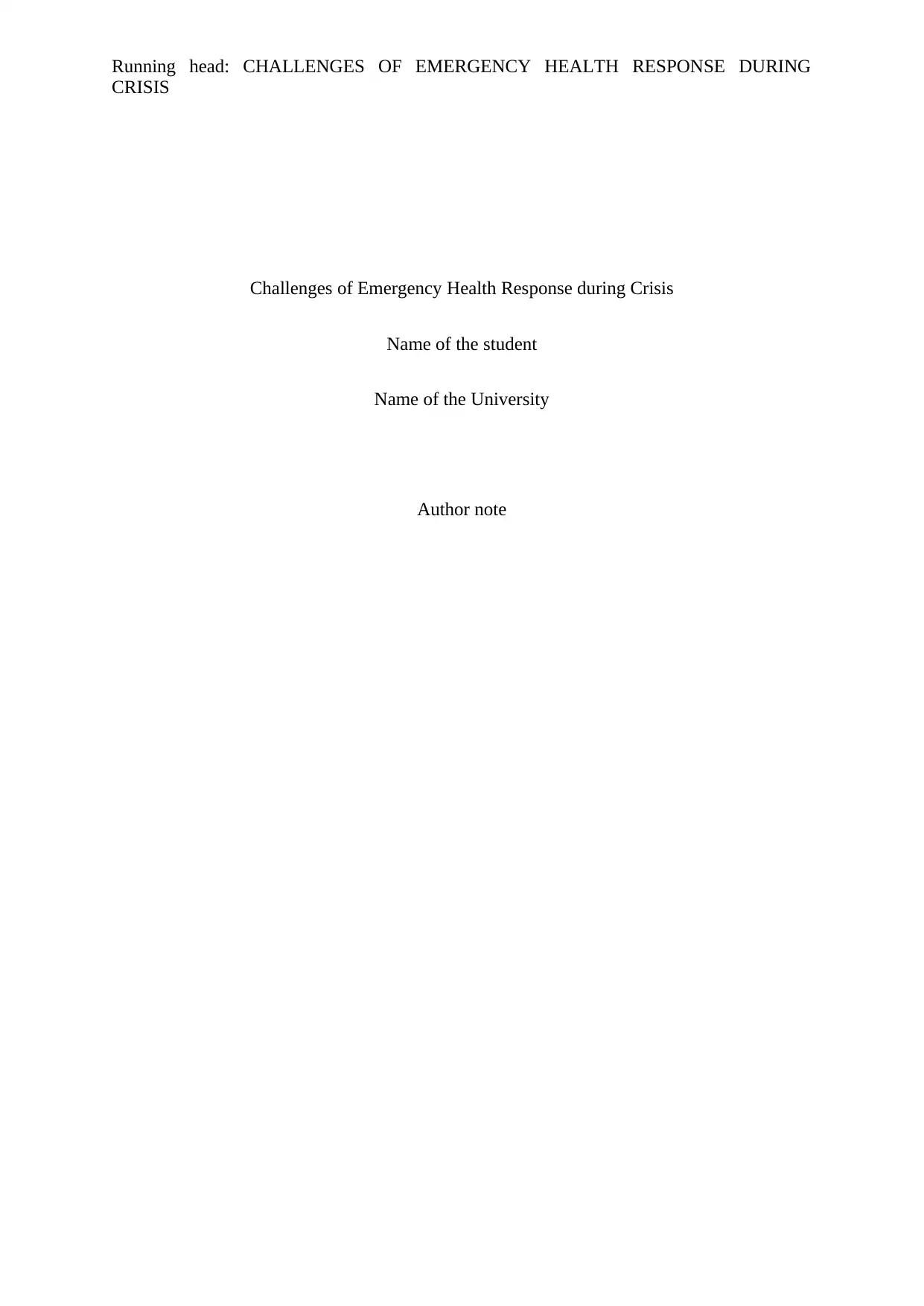
Running head: CHALLENGES OF EMERGENCY HEALTH RESPONSE DURING
CRISIS
Challenges of Emergency Health Response during Crisis
Name of the student
Name of the University
Author note
CRISIS
Challenges of Emergency Health Response during Crisis
Name of the student
Name of the University
Author note
Secure Best Marks with AI Grader
Need help grading? Try our AI Grader for instant feedback on your assignments.
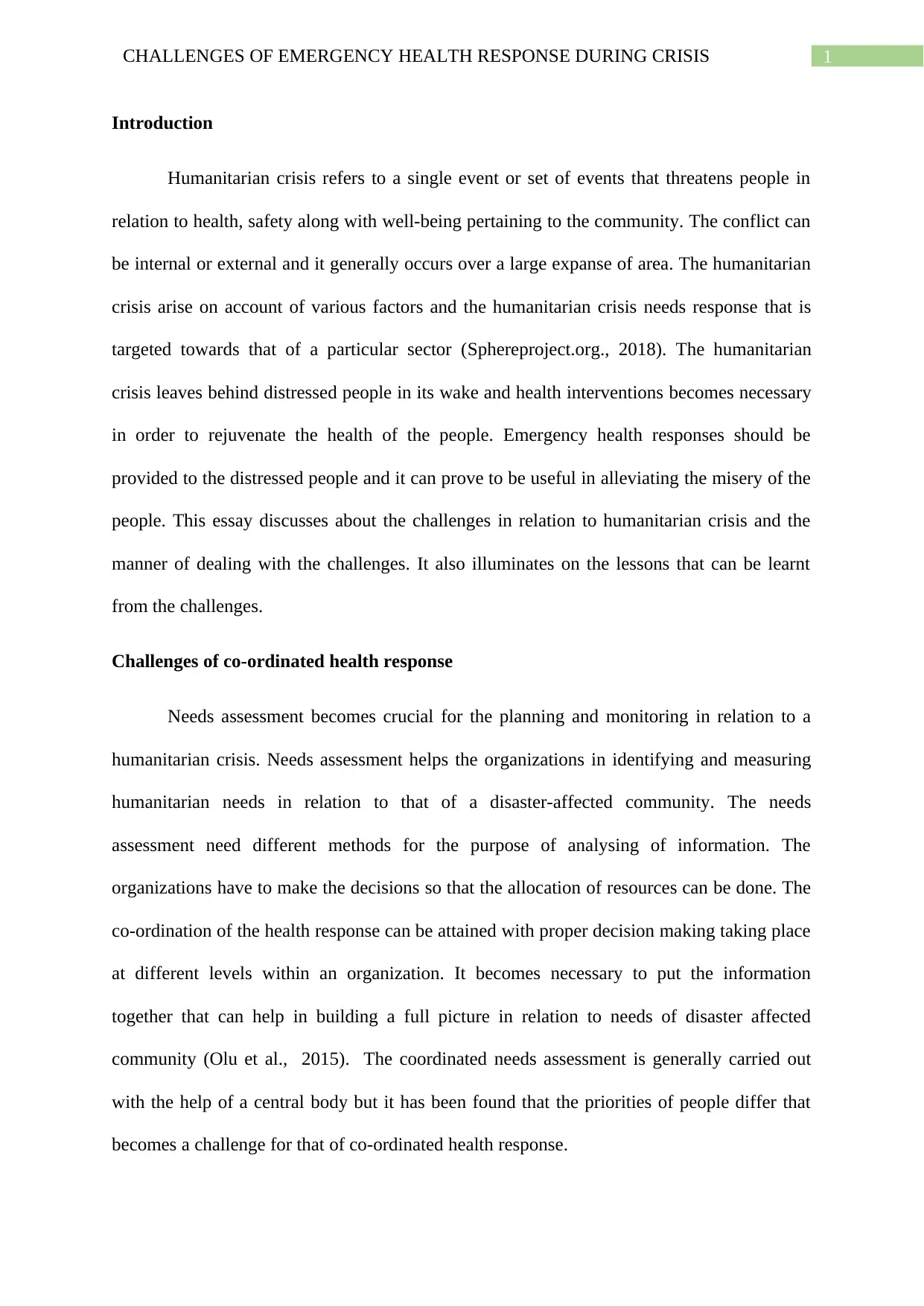
1CHALLENGES OF EMERGENCY HEALTH RESPONSE DURING CRISIS
Introduction
Humanitarian crisis refers to a single event or set of events that threatens people in
relation to health, safety along with well-being pertaining to the community. The conflict can
be internal or external and it generally occurs over a large expanse of area. The humanitarian
crisis arise on account of various factors and the humanitarian crisis needs response that is
targeted towards that of a particular sector (Sphereproject.org., 2018). The humanitarian
crisis leaves behind distressed people in its wake and health interventions becomes necessary
in order to rejuvenate the health of the people. Emergency health responses should be
provided to the distressed people and it can prove to be useful in alleviating the misery of the
people. This essay discusses about the challenges in relation to humanitarian crisis and the
manner of dealing with the challenges. It also illuminates on the lessons that can be learnt
from the challenges.
Challenges of co-ordinated health response
Needs assessment becomes crucial for the planning and monitoring in relation to a
humanitarian crisis. Needs assessment helps the organizations in identifying and measuring
humanitarian needs in relation to that of a disaster-affected community. The needs
assessment need different methods for the purpose of analysing of information. The
organizations have to make the decisions so that the allocation of resources can be done. The
co-ordination of the health response can be attained with proper decision making taking place
at different levels within an organization. It becomes necessary to put the information
together that can help in building a full picture in relation to needs of disaster affected
community (Olu et al., 2015). The coordinated needs assessment is generally carried out
with the help of a central body but it has been found that the priorities of people differ that
becomes a challenge for that of co-ordinated health response.
Introduction
Humanitarian crisis refers to a single event or set of events that threatens people in
relation to health, safety along with well-being pertaining to the community. The conflict can
be internal or external and it generally occurs over a large expanse of area. The humanitarian
crisis arise on account of various factors and the humanitarian crisis needs response that is
targeted towards that of a particular sector (Sphereproject.org., 2018). The humanitarian
crisis leaves behind distressed people in its wake and health interventions becomes necessary
in order to rejuvenate the health of the people. Emergency health responses should be
provided to the distressed people and it can prove to be useful in alleviating the misery of the
people. This essay discusses about the challenges in relation to humanitarian crisis and the
manner of dealing with the challenges. It also illuminates on the lessons that can be learnt
from the challenges.
Challenges of co-ordinated health response
Needs assessment becomes crucial for the planning and monitoring in relation to a
humanitarian crisis. Needs assessment helps the organizations in identifying and measuring
humanitarian needs in relation to that of a disaster-affected community. The needs
assessment need different methods for the purpose of analysing of information. The
organizations have to make the decisions so that the allocation of resources can be done. The
co-ordination of the health response can be attained with proper decision making taking place
at different levels within an organization. It becomes necessary to put the information
together that can help in building a full picture in relation to needs of disaster affected
community (Olu et al., 2015). The coordinated needs assessment is generally carried out
with the help of a central body but it has been found that the priorities of people differ that
becomes a challenge for that of co-ordinated health response.
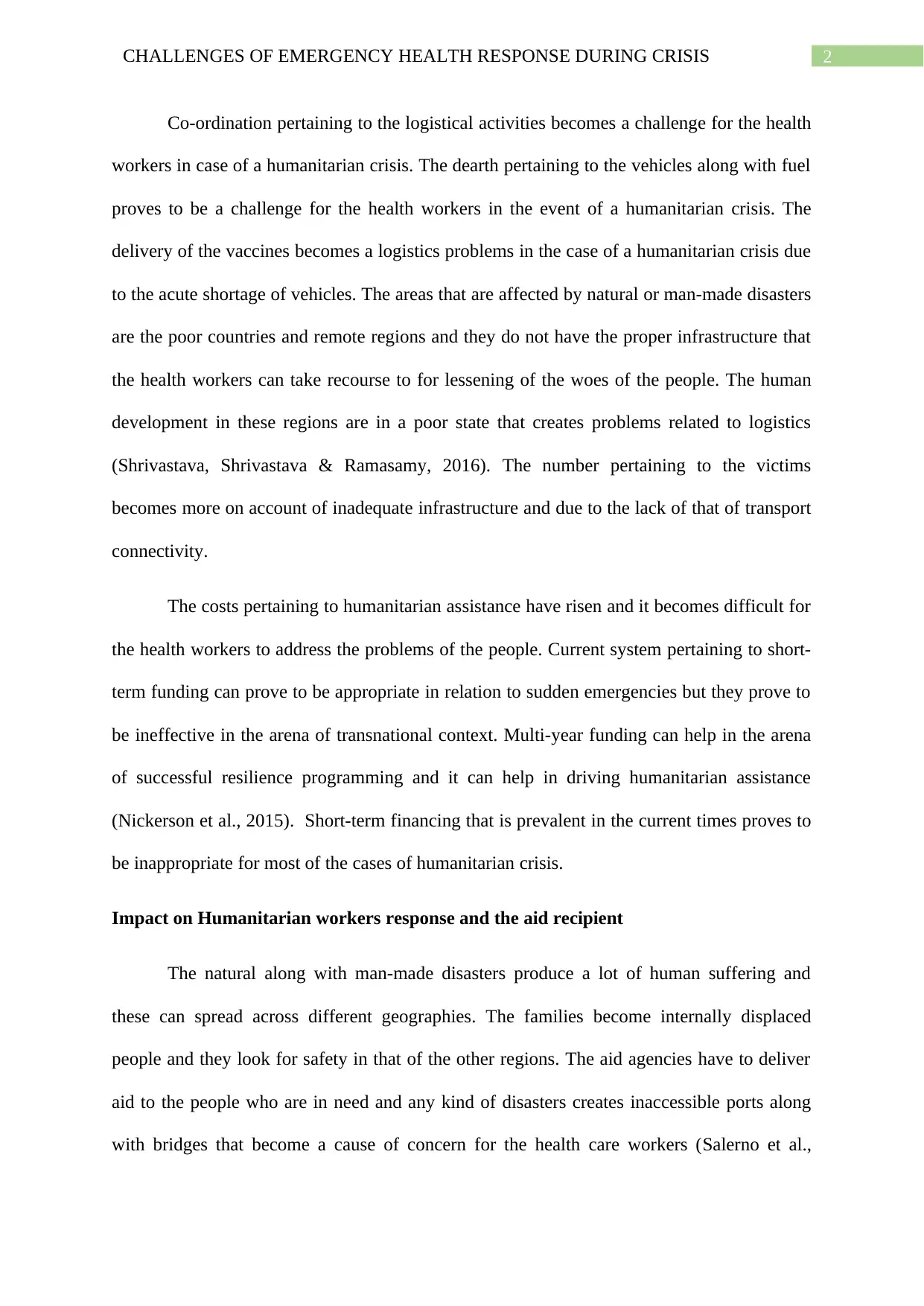
2CHALLENGES OF EMERGENCY HEALTH RESPONSE DURING CRISIS
Co-ordination pertaining to the logistical activities becomes a challenge for the health
workers in case of a humanitarian crisis. The dearth pertaining to the vehicles along with fuel
proves to be a challenge for the health workers in the event of a humanitarian crisis. The
delivery of the vaccines becomes a logistics problems in the case of a humanitarian crisis due
to the acute shortage of vehicles. The areas that are affected by natural or man-made disasters
are the poor countries and remote regions and they do not have the proper infrastructure that
the health workers can take recourse to for lessening of the woes of the people. The human
development in these regions are in a poor state that creates problems related to logistics
(Shrivastava, Shrivastava & Ramasamy, 2016). The number pertaining to the victims
becomes more on account of inadequate infrastructure and due to the lack of that of transport
connectivity.
The costs pertaining to humanitarian assistance have risen and it becomes difficult for
the health workers to address the problems of the people. Current system pertaining to short-
term funding can prove to be appropriate in relation to sudden emergencies but they prove to
be ineffective in the arena of transnational context. Multi-year funding can help in the arena
of successful resilience programming and it can help in driving humanitarian assistance
(Nickerson et al., 2015). Short-term financing that is prevalent in the current times proves to
be inappropriate for most of the cases of humanitarian crisis.
Impact on Humanitarian workers response and the aid recipient
The natural along with man-made disasters produce a lot of human suffering and
these can spread across different geographies. The families become internally displaced
people and they look for safety in that of the other regions. The aid agencies have to deliver
aid to the people who are in need and any kind of disasters creates inaccessible ports along
with bridges that become a cause of concern for the health care workers (Salerno et al.,
Co-ordination pertaining to the logistical activities becomes a challenge for the health
workers in case of a humanitarian crisis. The dearth pertaining to the vehicles along with fuel
proves to be a challenge for the health workers in the event of a humanitarian crisis. The
delivery of the vaccines becomes a logistics problems in the case of a humanitarian crisis due
to the acute shortage of vehicles. The areas that are affected by natural or man-made disasters
are the poor countries and remote regions and they do not have the proper infrastructure that
the health workers can take recourse to for lessening of the woes of the people. The human
development in these regions are in a poor state that creates problems related to logistics
(Shrivastava, Shrivastava & Ramasamy, 2016). The number pertaining to the victims
becomes more on account of inadequate infrastructure and due to the lack of that of transport
connectivity.
The costs pertaining to humanitarian assistance have risen and it becomes difficult for
the health workers to address the problems of the people. Current system pertaining to short-
term funding can prove to be appropriate in relation to sudden emergencies but they prove to
be ineffective in the arena of transnational context. Multi-year funding can help in the arena
of successful resilience programming and it can help in driving humanitarian assistance
(Nickerson et al., 2015). Short-term financing that is prevalent in the current times proves to
be inappropriate for most of the cases of humanitarian crisis.
Impact on Humanitarian workers response and the aid recipient
The natural along with man-made disasters produce a lot of human suffering and
these can spread across different geographies. The families become internally displaced
people and they look for safety in that of the other regions. The aid agencies have to deliver
aid to the people who are in need and any kind of disasters creates inaccessible ports along
with bridges that become a cause of concern for the health care workers (Salerno et al.,
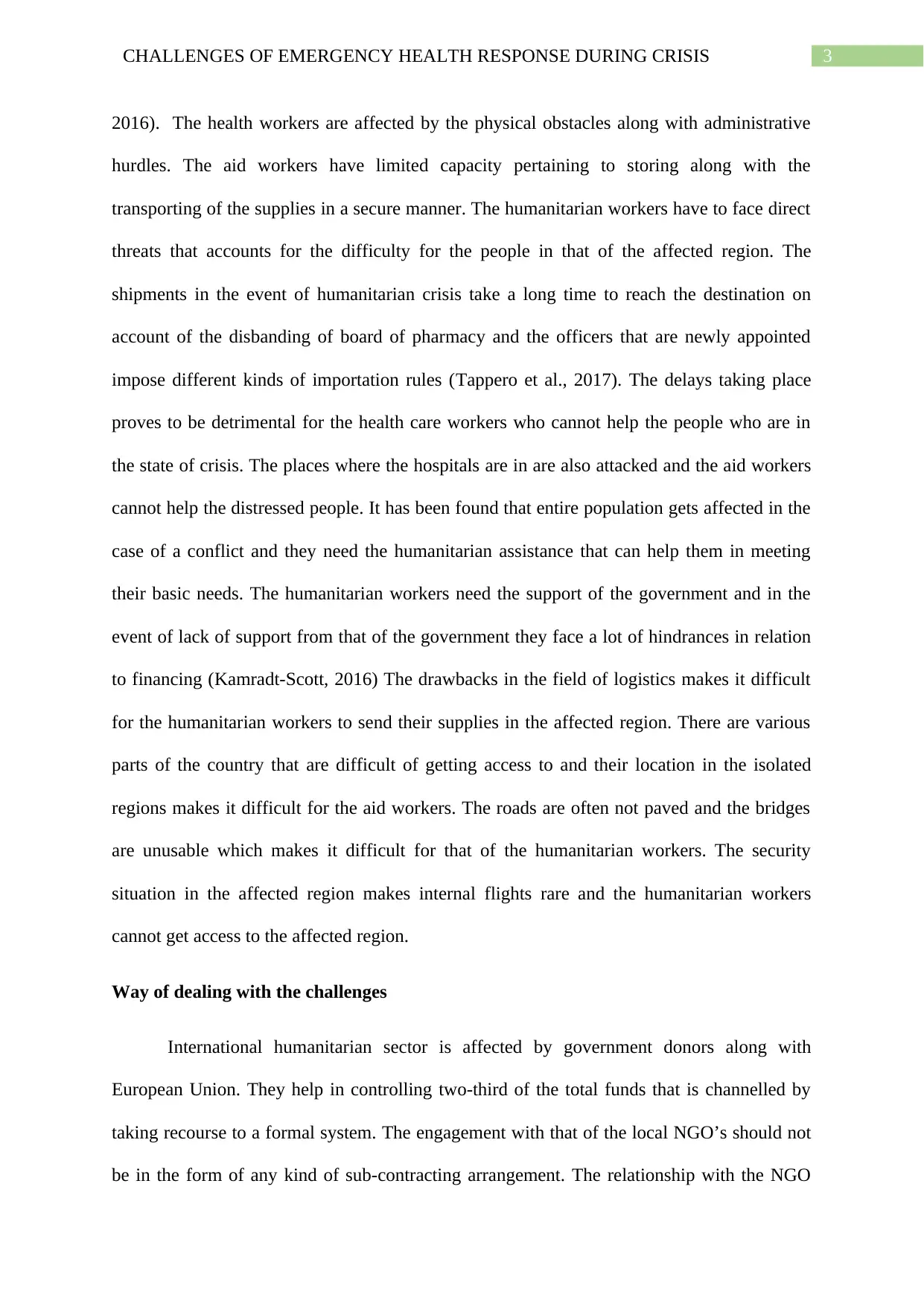
3CHALLENGES OF EMERGENCY HEALTH RESPONSE DURING CRISIS
2016). The health workers are affected by the physical obstacles along with administrative
hurdles. The aid workers have limited capacity pertaining to storing along with the
transporting of the supplies in a secure manner. The humanitarian workers have to face direct
threats that accounts for the difficulty for the people in that of the affected region. The
shipments in the event of humanitarian crisis take a long time to reach the destination on
account of the disbanding of board of pharmacy and the officers that are newly appointed
impose different kinds of importation rules (Tappero et al., 2017). The delays taking place
proves to be detrimental for the health care workers who cannot help the people who are in
the state of crisis. The places where the hospitals are in are also attacked and the aid workers
cannot help the distressed people. It has been found that entire population gets affected in the
case of a conflict and they need the humanitarian assistance that can help them in meeting
their basic needs. The humanitarian workers need the support of the government and in the
event of lack of support from that of the government they face a lot of hindrances in relation
to financing (Kamradt-Scott, 2016) The drawbacks in the field of logistics makes it difficult
for the humanitarian workers to send their supplies in the affected region. There are various
parts of the country that are difficult of getting access to and their location in the isolated
regions makes it difficult for the aid workers. The roads are often not paved and the bridges
are unusable which makes it difficult for that of the humanitarian workers. The security
situation in the affected region makes internal flights rare and the humanitarian workers
cannot get access to the affected region.
Way of dealing with the challenges
International humanitarian sector is affected by government donors along with
European Union. They help in controlling two-third of the total funds that is channelled by
taking recourse to a formal system. The engagement with that of the local NGO’s should not
be in the form of any kind of sub-contracting arrangement. The relationship with the NGO
2016). The health workers are affected by the physical obstacles along with administrative
hurdles. The aid workers have limited capacity pertaining to storing along with the
transporting of the supplies in a secure manner. The humanitarian workers have to face direct
threats that accounts for the difficulty for the people in that of the affected region. The
shipments in the event of humanitarian crisis take a long time to reach the destination on
account of the disbanding of board of pharmacy and the officers that are newly appointed
impose different kinds of importation rules (Tappero et al., 2017). The delays taking place
proves to be detrimental for the health care workers who cannot help the people who are in
the state of crisis. The places where the hospitals are in are also attacked and the aid workers
cannot help the distressed people. It has been found that entire population gets affected in the
case of a conflict and they need the humanitarian assistance that can help them in meeting
their basic needs. The humanitarian workers need the support of the government and in the
event of lack of support from that of the government they face a lot of hindrances in relation
to financing (Kamradt-Scott, 2016) The drawbacks in the field of logistics makes it difficult
for the humanitarian workers to send their supplies in the affected region. There are various
parts of the country that are difficult of getting access to and their location in the isolated
regions makes it difficult for the aid workers. The roads are often not paved and the bridges
are unusable which makes it difficult for that of the humanitarian workers. The security
situation in the affected region makes internal flights rare and the humanitarian workers
cannot get access to the affected region.
Way of dealing with the challenges
International humanitarian sector is affected by government donors along with
European Union. They help in controlling two-third of the total funds that is channelled by
taking recourse to a formal system. The engagement with that of the local NGO’s should not
be in the form of any kind of sub-contracting arrangement. The relationship with the NGO
Secure Best Marks with AI Grader
Need help grading? Try our AI Grader for instant feedback on your assignments.
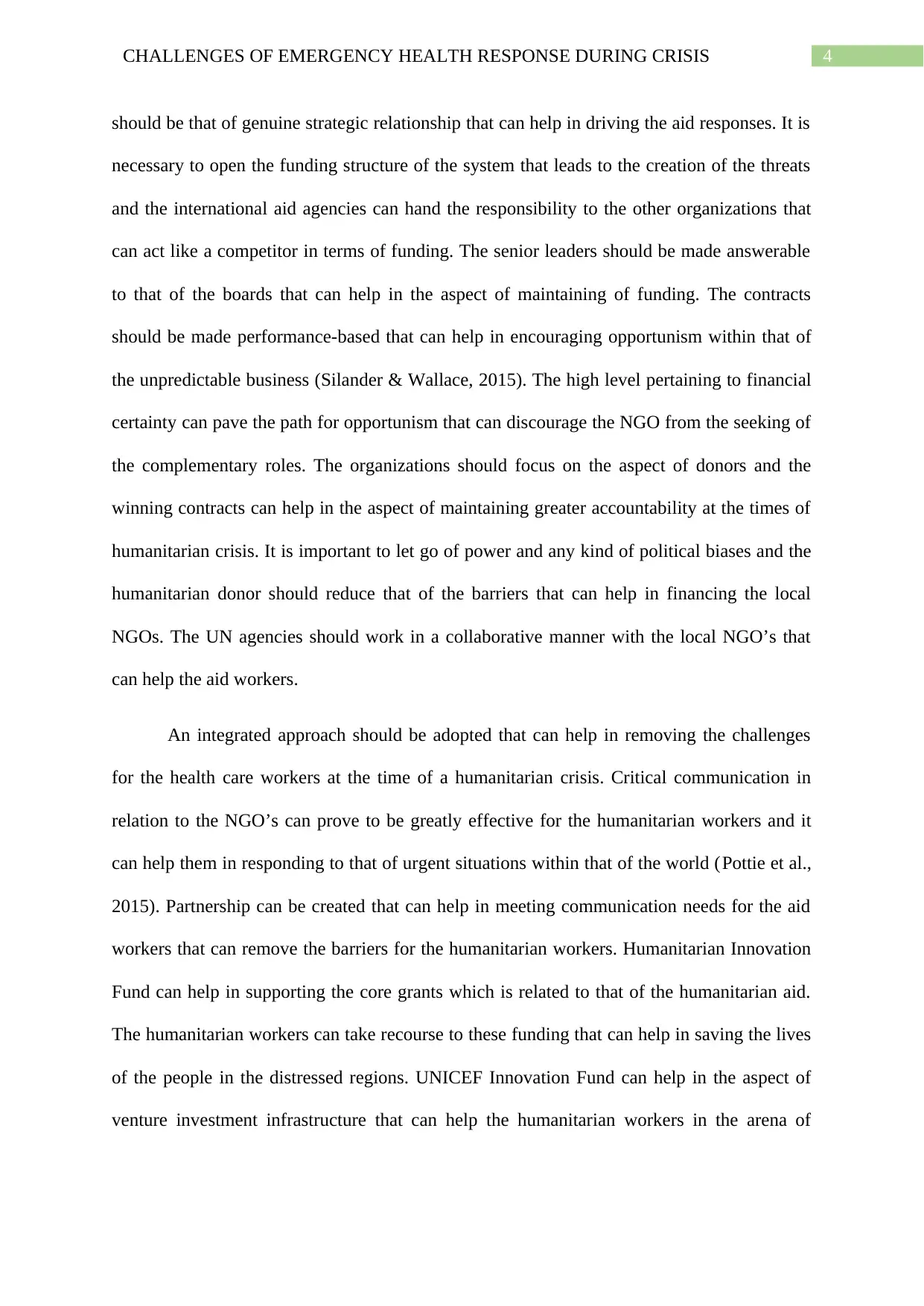
4CHALLENGES OF EMERGENCY HEALTH RESPONSE DURING CRISIS
should be that of genuine strategic relationship that can help in driving the aid responses. It is
necessary to open the funding structure of the system that leads to the creation of the threats
and the international aid agencies can hand the responsibility to the other organizations that
can act like a competitor in terms of funding. The senior leaders should be made answerable
to that of the boards that can help in the aspect of maintaining of funding. The contracts
should be made performance-based that can help in encouraging opportunism within that of
the unpredictable business (Silander & Wallace, 2015). The high level pertaining to financial
certainty can pave the path for opportunism that can discourage the NGO from the seeking of
the complementary roles. The organizations should focus on the aspect of donors and the
winning contracts can help in the aspect of maintaining greater accountability at the times of
humanitarian crisis. It is important to let go of power and any kind of political biases and the
humanitarian donor should reduce that of the barriers that can help in financing the local
NGOs. The UN agencies should work in a collaborative manner with the local NGO’s that
can help the aid workers.
An integrated approach should be adopted that can help in removing the challenges
for the health care workers at the time of a humanitarian crisis. Critical communication in
relation to the NGO’s can prove to be greatly effective for the humanitarian workers and it
can help them in responding to that of urgent situations within that of the world (Pottie et al.,
2015). Partnership can be created that can help in meeting communication needs for the aid
workers that can remove the barriers for the humanitarian workers. Humanitarian Innovation
Fund can help in supporting the core grants which is related to that of the humanitarian aid.
The humanitarian workers can take recourse to these funding that can help in saving the lives
of the people in the distressed regions. UNICEF Innovation Fund can help in the aspect of
venture investment infrastructure that can help the humanitarian workers in the arena of
should be that of genuine strategic relationship that can help in driving the aid responses. It is
necessary to open the funding structure of the system that leads to the creation of the threats
and the international aid agencies can hand the responsibility to the other organizations that
can act like a competitor in terms of funding. The senior leaders should be made answerable
to that of the boards that can help in the aspect of maintaining of funding. The contracts
should be made performance-based that can help in encouraging opportunism within that of
the unpredictable business (Silander & Wallace, 2015). The high level pertaining to financial
certainty can pave the path for opportunism that can discourage the NGO from the seeking of
the complementary roles. The organizations should focus on the aspect of donors and the
winning contracts can help in the aspect of maintaining greater accountability at the times of
humanitarian crisis. It is important to let go of power and any kind of political biases and the
humanitarian donor should reduce that of the barriers that can help in financing the local
NGOs. The UN agencies should work in a collaborative manner with the local NGO’s that
can help the aid workers.
An integrated approach should be adopted that can help in removing the challenges
for the health care workers at the time of a humanitarian crisis. Critical communication in
relation to the NGO’s can prove to be greatly effective for the humanitarian workers and it
can help them in responding to that of urgent situations within that of the world (Pottie et al.,
2015). Partnership can be created that can help in meeting communication needs for the aid
workers that can remove the barriers for the humanitarian workers. Humanitarian Innovation
Fund can help in supporting the core grants which is related to that of the humanitarian aid.
The humanitarian workers can take recourse to these funding that can help in saving the lives
of the people in the distressed regions. UNICEF Innovation Fund can help in the aspect of
venture investment infrastructure that can help the humanitarian workers in the arena of
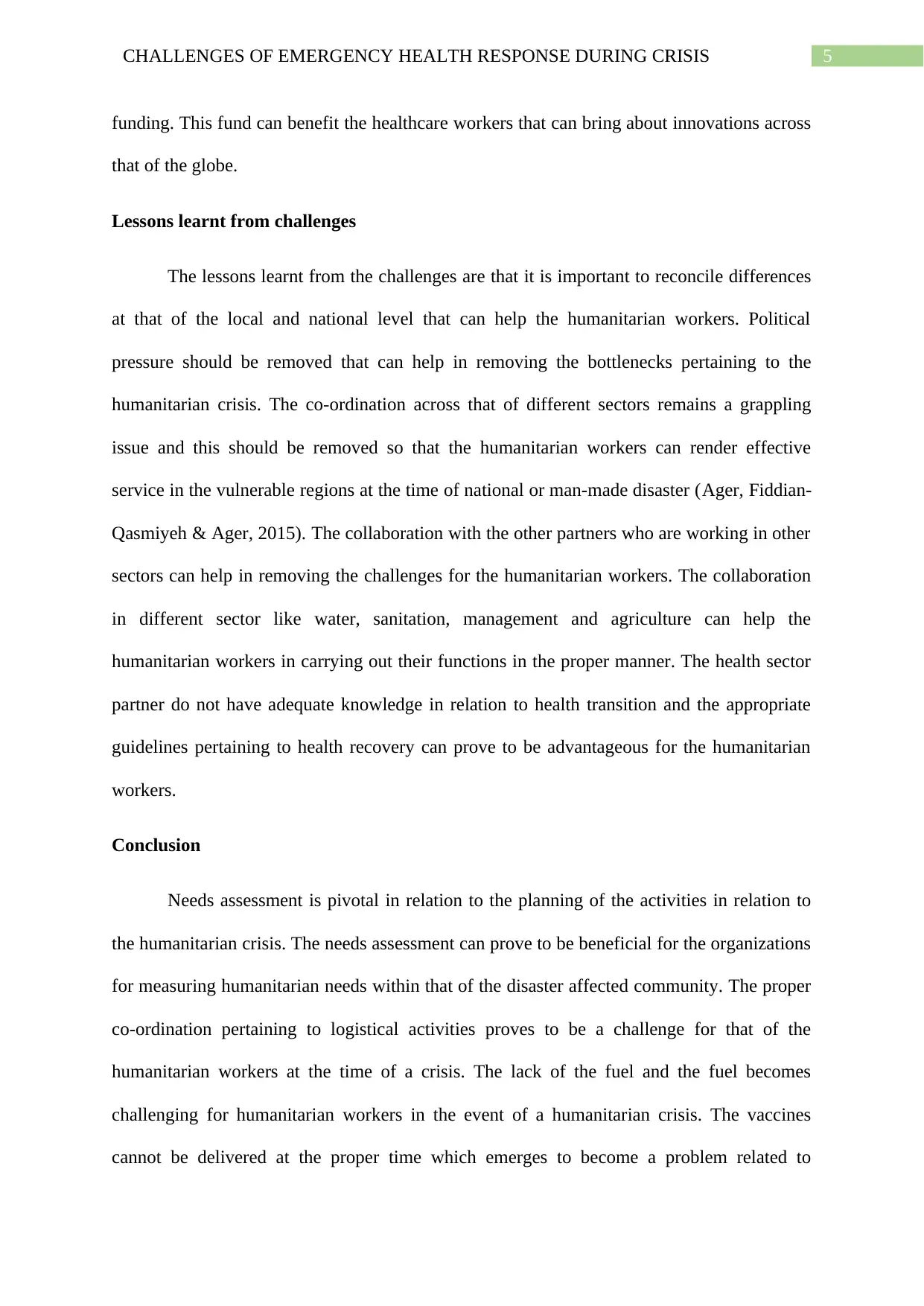
5CHALLENGES OF EMERGENCY HEALTH RESPONSE DURING CRISIS
funding. This fund can benefit the healthcare workers that can bring about innovations across
that of the globe.
Lessons learnt from challenges
The lessons learnt from the challenges are that it is important to reconcile differences
at that of the local and national level that can help the humanitarian workers. Political
pressure should be removed that can help in removing the bottlenecks pertaining to the
humanitarian crisis. The co-ordination across that of different sectors remains a grappling
issue and this should be removed so that the humanitarian workers can render effective
service in the vulnerable regions at the time of national or man-made disaster (Ager, Fiddian-
Qasmiyeh & Ager, 2015). The collaboration with the other partners who are working in other
sectors can help in removing the challenges for the humanitarian workers. The collaboration
in different sector like water, sanitation, management and agriculture can help the
humanitarian workers in carrying out their functions in the proper manner. The health sector
partner do not have adequate knowledge in relation to health transition and the appropriate
guidelines pertaining to health recovery can prove to be advantageous for the humanitarian
workers.
Conclusion
Needs assessment is pivotal in relation to the planning of the activities in relation to
the humanitarian crisis. The needs assessment can prove to be beneficial for the organizations
for measuring humanitarian needs within that of the disaster affected community. The proper
co-ordination pertaining to logistical activities proves to be a challenge for that of the
humanitarian workers at the time of a crisis. The lack of the fuel and the fuel becomes
challenging for humanitarian workers in the event of a humanitarian crisis. The vaccines
cannot be delivered at the proper time which emerges to become a problem related to
funding. This fund can benefit the healthcare workers that can bring about innovations across
that of the globe.
Lessons learnt from challenges
The lessons learnt from the challenges are that it is important to reconcile differences
at that of the local and national level that can help the humanitarian workers. Political
pressure should be removed that can help in removing the bottlenecks pertaining to the
humanitarian crisis. The co-ordination across that of different sectors remains a grappling
issue and this should be removed so that the humanitarian workers can render effective
service in the vulnerable regions at the time of national or man-made disaster (Ager, Fiddian-
Qasmiyeh & Ager, 2015). The collaboration with the other partners who are working in other
sectors can help in removing the challenges for the humanitarian workers. The collaboration
in different sector like water, sanitation, management and agriculture can help the
humanitarian workers in carrying out their functions in the proper manner. The health sector
partner do not have adequate knowledge in relation to health transition and the appropriate
guidelines pertaining to health recovery can prove to be advantageous for the humanitarian
workers.
Conclusion
Needs assessment is pivotal in relation to the planning of the activities in relation to
the humanitarian crisis. The needs assessment can prove to be beneficial for the organizations
for measuring humanitarian needs within that of the disaster affected community. The proper
co-ordination pertaining to logistical activities proves to be a challenge for that of the
humanitarian workers at the time of a crisis. The lack of the fuel and the fuel becomes
challenging for humanitarian workers in the event of a humanitarian crisis. The vaccines
cannot be delivered at the proper time which emerges to become a problem related to
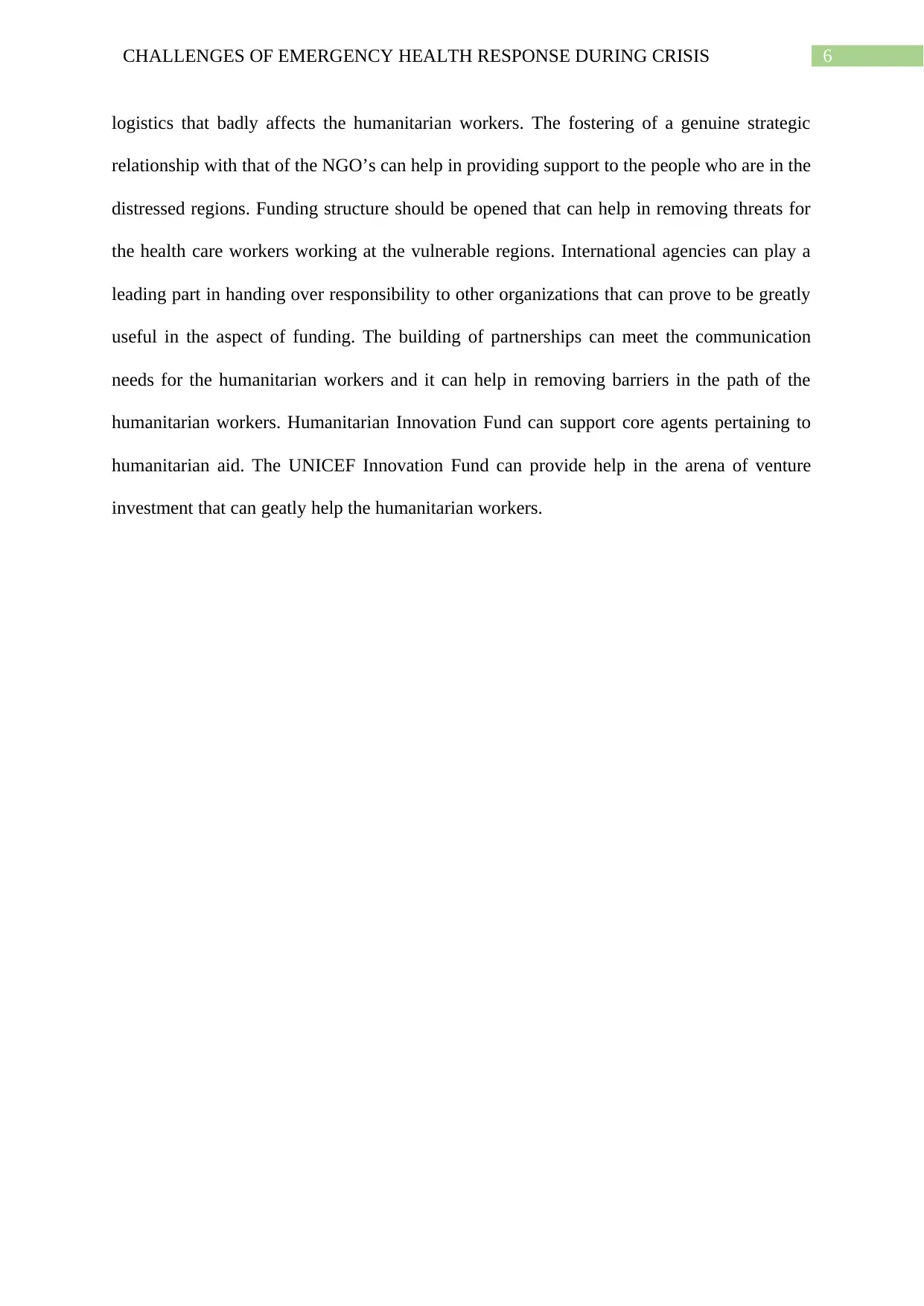
6CHALLENGES OF EMERGENCY HEALTH RESPONSE DURING CRISIS
logistics that badly affects the humanitarian workers. The fostering of a genuine strategic
relationship with that of the NGO’s can help in providing support to the people who are in the
distressed regions. Funding structure should be opened that can help in removing threats for
the health care workers working at the vulnerable regions. International agencies can play a
leading part in handing over responsibility to other organizations that can prove to be greatly
useful in the aspect of funding. The building of partnerships can meet the communication
needs for the humanitarian workers and it can help in removing barriers in the path of the
humanitarian workers. Humanitarian Innovation Fund can support core agents pertaining to
humanitarian aid. The UNICEF Innovation Fund can provide help in the arena of venture
investment that can geatly help the humanitarian workers.
logistics that badly affects the humanitarian workers. The fostering of a genuine strategic
relationship with that of the NGO’s can help in providing support to the people who are in the
distressed regions. Funding structure should be opened that can help in removing threats for
the health care workers working at the vulnerable regions. International agencies can play a
leading part in handing over responsibility to other organizations that can prove to be greatly
useful in the aspect of funding. The building of partnerships can meet the communication
needs for the humanitarian workers and it can help in removing barriers in the path of the
humanitarian workers. Humanitarian Innovation Fund can support core agents pertaining to
humanitarian aid. The UNICEF Innovation Fund can provide help in the arena of venture
investment that can geatly help the humanitarian workers.
Paraphrase This Document
Need a fresh take? Get an instant paraphrase of this document with our AI Paraphraser
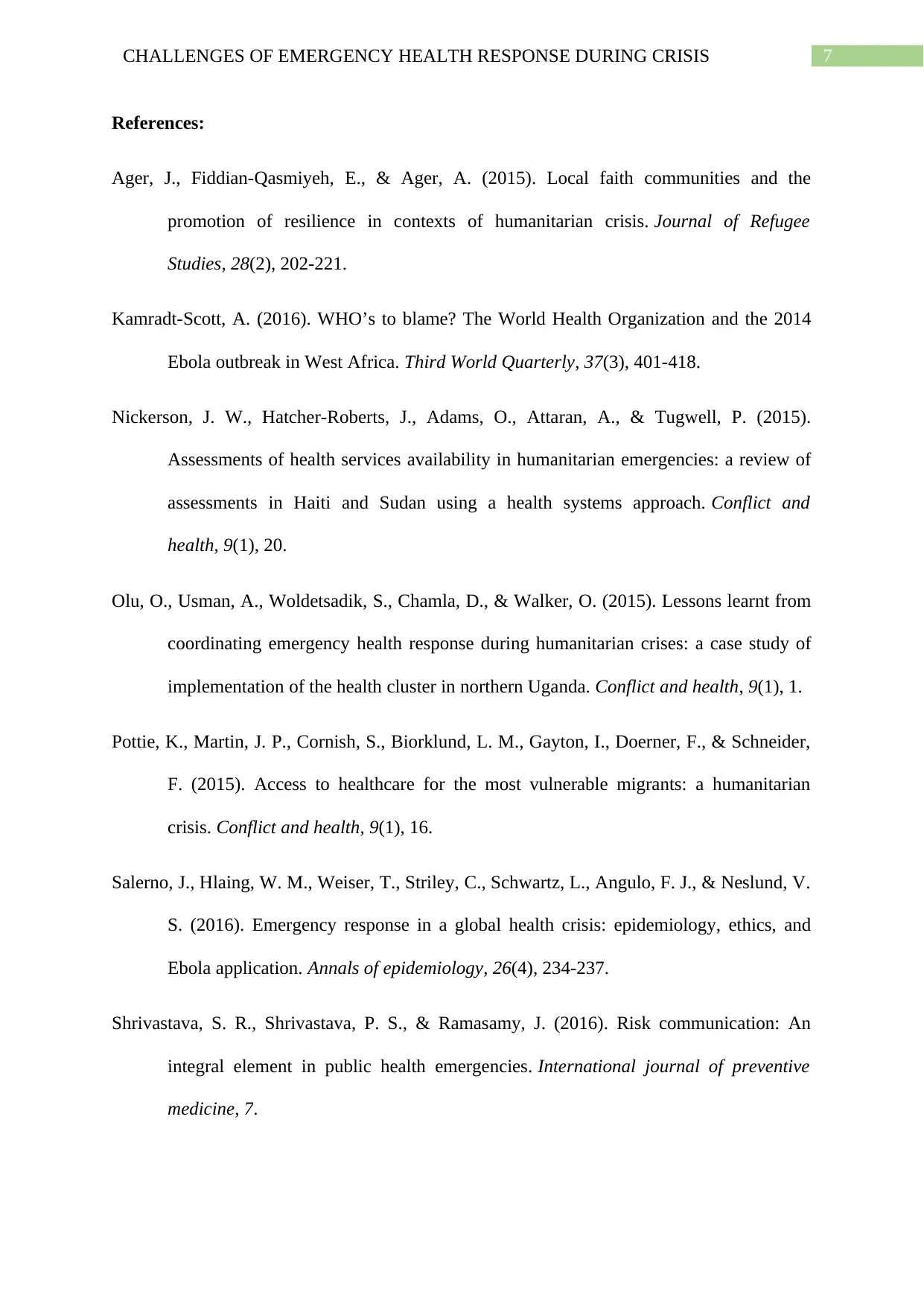
7CHALLENGES OF EMERGENCY HEALTH RESPONSE DURING CRISIS
References:
Ager, J., Fiddian-Qasmiyeh, E., & Ager, A. (2015). Local faith communities and the
promotion of resilience in contexts of humanitarian crisis. Journal of Refugee
Studies, 28(2), 202-221.
Kamradt-Scott, A. (2016). WHO’s to blame? The World Health Organization and the 2014
Ebola outbreak in West Africa. Third World Quarterly, 37(3), 401-418.
Nickerson, J. W., Hatcher-Roberts, J., Adams, O., Attaran, A., & Tugwell, P. (2015).
Assessments of health services availability in humanitarian emergencies: a review of
assessments in Haiti and Sudan using a health systems approach. Conflict and
health, 9(1), 20.
Olu, O., Usman, A., Woldetsadik, S., Chamla, D., & Walker, O. (2015). Lessons learnt from
coordinating emergency health response during humanitarian crises: a case study of
implementation of the health cluster in northern Uganda. Conflict and health, 9(1), 1.
Pottie, K., Martin, J. P., Cornish, S., Biorklund, L. M., Gayton, I., Doerner, F., & Schneider,
F. (2015). Access to healthcare for the most vulnerable migrants: a humanitarian
crisis. Conflict and health, 9(1), 16.
Salerno, J., Hlaing, W. M., Weiser, T., Striley, C., Schwartz, L., Angulo, F. J., & Neslund, V.
S. (2016). Emergency response in a global health crisis: epidemiology, ethics, and
Ebola application. Annals of epidemiology, 26(4), 234-237.
Shrivastava, S. R., Shrivastava, P. S., & Ramasamy, J. (2016). Risk communication: An
integral element in public health emergencies. International journal of preventive
medicine, 7.
References:
Ager, J., Fiddian-Qasmiyeh, E., & Ager, A. (2015). Local faith communities and the
promotion of resilience in contexts of humanitarian crisis. Journal of Refugee
Studies, 28(2), 202-221.
Kamradt-Scott, A. (2016). WHO’s to blame? The World Health Organization and the 2014
Ebola outbreak in West Africa. Third World Quarterly, 37(3), 401-418.
Nickerson, J. W., Hatcher-Roberts, J., Adams, O., Attaran, A., & Tugwell, P. (2015).
Assessments of health services availability in humanitarian emergencies: a review of
assessments in Haiti and Sudan using a health systems approach. Conflict and
health, 9(1), 20.
Olu, O., Usman, A., Woldetsadik, S., Chamla, D., & Walker, O. (2015). Lessons learnt from
coordinating emergency health response during humanitarian crises: a case study of
implementation of the health cluster in northern Uganda. Conflict and health, 9(1), 1.
Pottie, K., Martin, J. P., Cornish, S., Biorklund, L. M., Gayton, I., Doerner, F., & Schneider,
F. (2015). Access to healthcare for the most vulnerable migrants: a humanitarian
crisis. Conflict and health, 9(1), 16.
Salerno, J., Hlaing, W. M., Weiser, T., Striley, C., Schwartz, L., Angulo, F. J., & Neslund, V.
S. (2016). Emergency response in a global health crisis: epidemiology, ethics, and
Ebola application. Annals of epidemiology, 26(4), 234-237.
Shrivastava, S. R., Shrivastava, P. S., & Ramasamy, J. (2016). Risk communication: An
integral element in public health emergencies. International journal of preventive
medicine, 7.
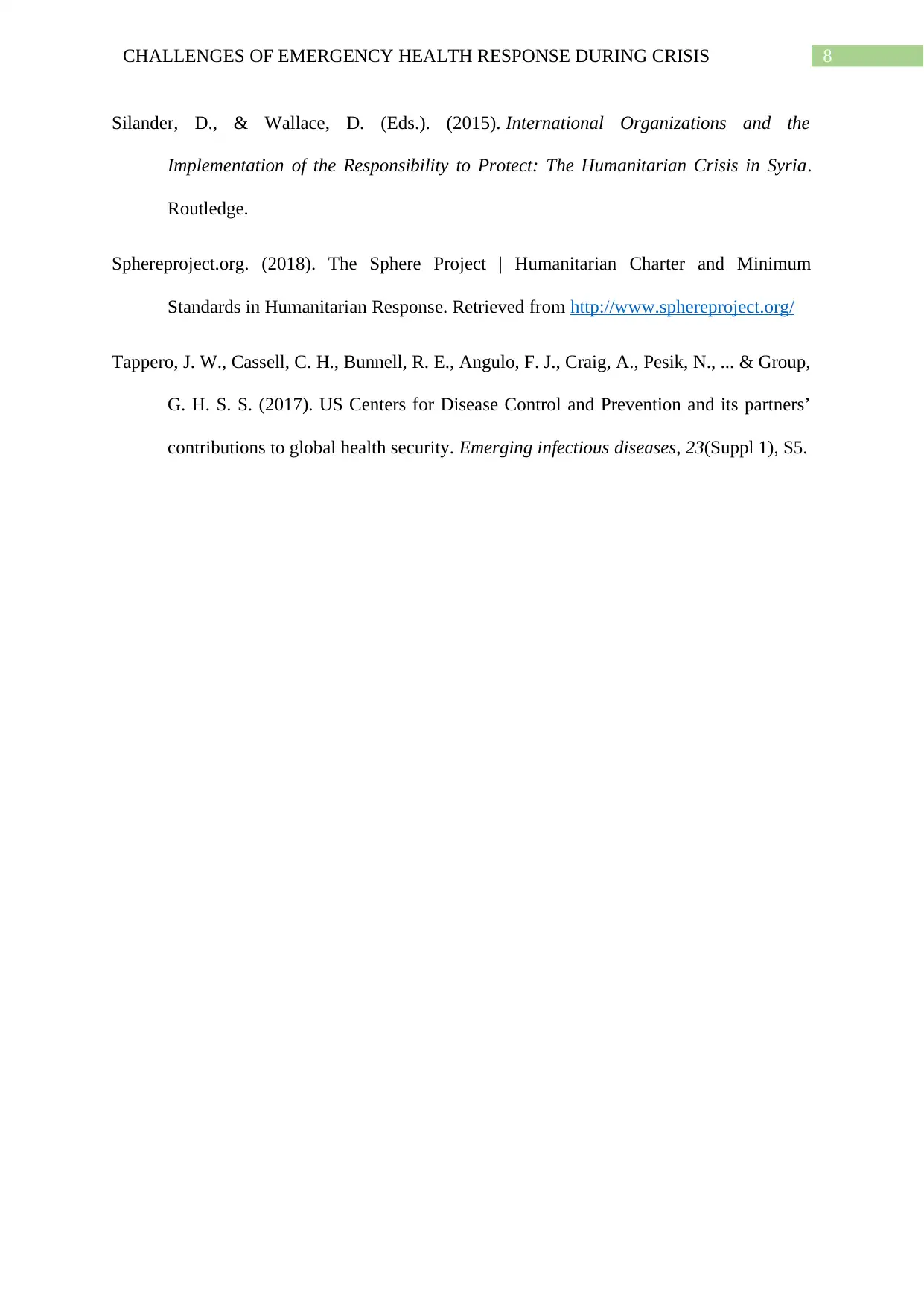
8CHALLENGES OF EMERGENCY HEALTH RESPONSE DURING CRISIS
Silander, D., & Wallace, D. (Eds.). (2015). International Organizations and the
Implementation of the Responsibility to Protect: The Humanitarian Crisis in Syria.
Routledge.
Sphereproject.org. (2018). The Sphere Project | Humanitarian Charter and Minimum
Standards in Humanitarian Response. Retrieved from http://www.sphereproject.org/
Tappero, J. W., Cassell, C. H., Bunnell, R. E., Angulo, F. J., Craig, A., Pesik, N., ... & Group,
G. H. S. S. (2017). US Centers for Disease Control and Prevention and its partners’
contributions to global health security. Emerging infectious diseases, 23(Suppl 1), S5.
Silander, D., & Wallace, D. (Eds.). (2015). International Organizations and the
Implementation of the Responsibility to Protect: The Humanitarian Crisis in Syria.
Routledge.
Sphereproject.org. (2018). The Sphere Project | Humanitarian Charter and Minimum
Standards in Humanitarian Response. Retrieved from http://www.sphereproject.org/
Tappero, J. W., Cassell, C. H., Bunnell, R. E., Angulo, F. J., Craig, A., Pesik, N., ... & Group,
G. H. S. S. (2017). US Centers for Disease Control and Prevention and its partners’
contributions to global health security. Emerging infectious diseases, 23(Suppl 1), S5.
1 out of 9
Related Documents
Your All-in-One AI-Powered Toolkit for Academic Success.
+13062052269
info@desklib.com
Available 24*7 on WhatsApp / Email
![[object Object]](/_next/static/media/star-bottom.7253800d.svg)
Unlock your academic potential
© 2024 | Zucol Services PVT LTD | All rights reserved.





